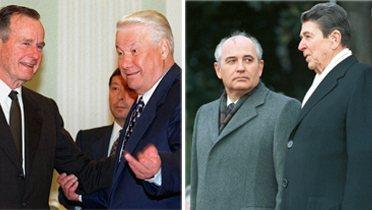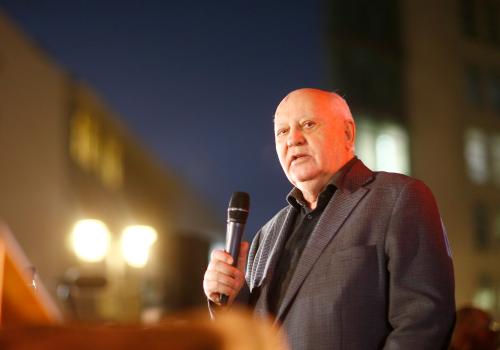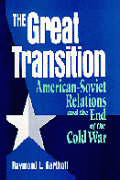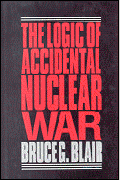Review of Jack F. Matlock Jr.’s book, Reagan and Gorbachev: How the Cold War Ended.
Ronald Reagan was widely eulogized for having won the cold war, liberated Eastern Europe and pulled the plug on the Soviet Union. Margaret Thatcher, Joe Lieberman, John McCain, Charles Krauthammer and other notables offered variations of The Economist‘s cover headline: “The Man Who Beat Communism.”
Actually, Jack F. Matlock Jr. writes in Reagan and Gorbachev, it was “not so simple.” He should know. A veteran foreign service officer and respected expert on the Soviet Union, he reached the pinnacle of his career under Reagan, serving first as the White House’s senior coordinator of policy toward the Soviet Union, then as ambassador to Moscow. In both the title of his memoir and the story it tells, he gives co-star billing to Mikhail Gorbachev.
Reagan himself went even farther. Asked at a press conference in Moscow in 1988, his last year in office, about the role he played in the great drama of the late 20th century, he described himself essentially as a supporting actor. “Mr. Gorbachev,” he said, “deserves most of the credit, as the leader of this country.”
This quotation was much cited at the time as an example of Reagan’s graciousness, tact and self-deprecation. But Matlock’s book bears out his former boss’s judgment. The 40th president of the United States emerges here not as a geopolitical visionary who jettisoned the supposedly accommodationist policies of containment and detente, but as an archpragmatist and operational optimist who adjusted his own attitudes and conduct in order to encourage a new kind of Kremlin leader.
During his first term, Reagan denounced the pre-Gorbachev Soviet Union as an “evil empire.” The name-calling riled many Soviets (and more than a few Sovietologists) but did little diplomatic harm, since relations between Washington and Moscow were already in a rut. The Kremlin had become a geriatric ward, with Red Square doubling as the world’s largest funeral parlor.
Then, in 1985, soon after Reagan’s second inauguration, the vigorous, 54-year-old Gorbachev ascended to the leadership. He wanted to demilitarize Soviet foreign policy so that he could divert resources to the Augean task of fixing a broken economy. Initially, he expected no help from Reagan, whom he regarded as “not simply a conservative, but a political ‘dinosaur.’”
For his part, Reagan assumed the new general secretary of the Communist Party would be “totally dedicated to traditional Soviet goals.” Nonetheless, he was prepared to test Prime Minister Thatcher’s first impression: ” like Mr. Gorbachev; we can do business together.”
Getting back into the business of diplomacy with the principal adversary of the United States appealed to Reagan, just as it had to six previous occupants of the Oval Office. Dwight D. Eisenhower and John F. Kennedy had tried to make the most of Nikita S. Khrushchev’s slogan of “peaceful coexistence”; Lyndon B. Johnson jump-started arms control talks with Aleksei N. Kosygin; Richard Nixon, Gerald R. Ford and Jimmy Carter signed strategic-arms limitation agreements with Leonid I. Brezhnev. But those Soviet leaders were committed, above all, to preserving the status quo. Sooner or later, each caused a setback or a showdown with the United States through some act of barbarity or recklessness: the crushing of the Hungarian uprising in 1956, the Cuban missile crisis in 1962, the invasions of Czechoslovakia in 1968 and Afghanistan in 1979, the destruction of a South Korean airliner that had wandered off course in 1983. Breakthroughs in United States-Soviet relations were inherently subject to breakdowns.
Gorbachev altered that dynamic. He was determined to take the Soviet Union in a radically different direction—away from the Big Lie (through his policy of glasnost), away from a command economy (through perestroika) and away from zero-sum competition with the West.
Reagan came quickly to recognize that Gorbachev’s goals, far from being traditional, were downright revolutionary. He also saw that the transformation Gorbachev had in mind for his country would, if it came about, serve American interests.
As a result, without much fuss and without many of his supporters noticing, Reagan underwent a transformation of his own. The fire-breathing cold warrior set about trying, through intense, sustained personal engagement, to convince Gorbachev that the United States would not make him sorry for the course he had chosen.
Matlock describes in telling detail how Reagan rehearsed for his first meeting with Gorbachev, which took place in Geneva in November 1985. Reagan assigned the role of the Soviet leader to Matlock who, for maximum authenticity, played his part in Russian, mimicking Gorbachev’s confident, loquacious style. Matlock also sent Reagan a series of “spoof memos” that were “interlaced with jokes and anecdotes,” based on an educated guess at what Gorbachev’s own advisers were telling him in preparation for the encounter.
Shortly before setting off for Geneva, Reagan dictated a long memo of his own, laying out his assessment of the man he was about to meet. The Reagan game plan was to look for areas of common interest, be candid about points of contention and support Gorbachev’s reforms while (in Matlock’s paraphrase) “avoiding any demand for ‘regime change.’” He cautioned the members of his administration not to rub Gorbachev’s nose in any concessions he might make. Above all, Reagan wanted to establish a relationship with his Soviet counterpart that would make it easier to manage conflicts lest they escalate to thermonuclear war—an imperative for every American president since Eisenhower.
Matlock puts the best light he can on Reagan’s dream of a Star Wars anti-missile system, but he stops short of perpetuating the claim, now an article of faith among many conservatives, that the prospect of an impregnable shield over the United States and an arms race in space caused the Soviets to throw in the towel. Instead, Matlock focuses on Reagan’s attempt to convince Gorbachev that American defense policy posed no threat to legitimate Soviet interests and should therefore not prevent the two leaders from establishing a high degree of mutual trust.
That word figured in Reagan’s mantra, “trust but verify.” It set Gorbachev’s teeth on edge. However, Reagan intended the motto not just as a caveat about dealing with the Soviets but also as a subtle admonition to his relentlessly hard-line and mistrustful secretary of defense, Caspar W. Weinberger. According to Matlock, Weinberger was “utterly convinced that there was no potential benefit in negotiating anything with the Soviet leaders and that most negotiations were dangerous traps.” The rivalry that Matlock describes between Weinberger and Secretary of State George P. Shultz bears an eerie similarity to what we know of the one between Colin L. Powell and Donald H. Rumsfeld. Shultz grew so exasperated with Weinberger’s militancy and obstructionism that he contemplated resigning. Reagan wrote in his diary, “I can’t let this happen. Actually, George is carrying out my policy.”
That policy, as Matlock summarizes it, “was consistent throughout.” Reagan “wanted to reduce the threat of war, to convince the Soviet leaders that cooperation could serve the Soviet peoples better than confrontation and to encourage openness and democracy in the Soviet Union.”
Presidential attachment to those precepts neither began nor ended with Ronald Reagan. It was Jimmy Carter who first put human rights prominently on the agenda of American-Soviet relations. George H. W. Bush skillfully served as a kind of air traffic controller in 1991, when the increasingly beleaguered Gorbachev brought the Soviet Union in for a relatively soft landing on the ash heap of history—a major contribution to the end of the cold war that Matlock dismisses in a footnote as “cleanup” diplomacy.
While Matlock could have been more charitable to Reagan’s predecessors and to his immediate successor, his account of Reagan’s achievement as the nation’s diplomat in chief is a public service as well as a contribution to the historical record. It is simultaneously admiring, authoritative and conscientious. It is also corrective, since it debunks much of the hype and spin with which we were blitzed earlier this summer. The truth is a better tribute to Reagan than the myth.









Commentary
Reagan and Gorbachev: Shutting the Cold War Down
August 1, 2004